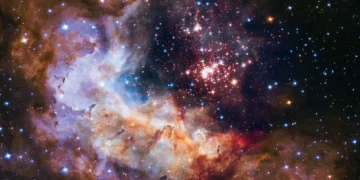The Vera C. Rubin Observatory, poised to come online in February 2025, promises to revolutionize our understanding of the universe. While the James Webb Space Telescope (JWST) has captivated the world with its stunning infrared images, the Rubin Observatory brings a completely different and complementary approach to astronomy. Situated high in the Andes Mountains of Chile, this telescope is designed to map the night sky with unprecedented speed and detail, tackling mysteries ranging from dark matter to near-Earth asteroids.
What Is the Vera C. Rubin Observatory?
The Vera C. Rubin Observatory is perched 2,700 meters above sea level on Cerro Pachón in Chile. Its location provides an unobstructed view of the Southern Hemisphere’s night sky, ideal for capturing wide-field images. At the heart of the observatory is its cutting-edge 3.2-gigapixel camera, the most advanced ever built for astronomy. This camera is capable of capturing images so detailed that a single frame could encompass an entire swath of the cosmos.
The observatory’s three-mirror design allows it to survey massive sections of the night sky, revisiting each area every three days. This cadence enables it to track dynamic phenomena like moving asteroids, flickering stars, and the rapid brightness changes of distant galaxies.
How Does the Rubin Observatory Compare to the James Webb Telescope?
While the JWST has dazzled with its ability to peer into the early universe using infrared imaging, the Rubin Observatory focuses on mapping the big picture. JWST specializes in zooming in on specific targets, such as distant galaxies or exoplanets, providing extraordinary detail. Rubin, on the other hand, excels at systematically scanning the sky to detect transient events and changes over time.
For instance, the Rubin Observatory will identify fleeting phenomena such as supernovae or gamma-ray bursts, allowing telescopes like JWST to focus their attention on these cosmic events. Together, they form a powerful duo, each filling gaps in the other’s capabilities to create a more comprehensive understanding of the universe.
Scientific Impact of the Rubin Observatory
One of Rubin’s most ambitious goals is to tackle the enigma of dark matter and dark energy, which together make up 95% of the universe. Despite their dominance, these phenomena remain largely misunderstood. By cataloging the movements of billions of galaxies, Rubin will provide astronomers with the data needed to map the large-scale structure of the cosmos.
Unveiling Our Solar Neighborhood
The Rubin Observatory isn’t just looking outward—it’s also monitoring our own solar system. By continuously scanning the skies, it will track near-Earth asteroids, helping scientists identify potential threats. Moreover, it could locate the elusive Planet Nine, a theorized world lurking in the outer reaches of our solar system. Rubin’s ability to track celestial objects with precision makes it an invaluable tool for planetary defense and solar system exploration.
A Data Powerhouse
Rubin will generate an unprecedented 20 terabytes of data every night, cataloging nearly 20 billion galaxies over a decade. This staggering volume of information will enable breakthroughs across multiple fields of astronomy, from understanding star formation to discovering entirely new cosmic phenomena. The observatory’s massive dataset will also serve as a treasure trove for artificial intelligence and machine learning applications, allowing researchers to uncover patterns and insights that would otherwise remain hidden.
Technological Innovation and Global Collaboration
The Vera C. Rubin Observatory is a testament to global teamwork. Its advanced 3.2-gigapixel camera was developed with significant contributions from France, while its vast datasets will be processed and stored on servers in Lyon. This international effort mirrors the collaborative spirit seen in other astronomical projects, such as the JWST, highlighting how science transcends borders.
Advanced Imaging Techniques
Rubin’s innovative design includes a three-mirror system that minimizes image distortion, enabling wide-field surveys with exceptional clarity. This technology, combined with its powerful camera, ensures that Rubin will capture the universe in unparalleled detail. The observatory’s ability to revisit the same sections of the sky every few days provides a dynamic view of celestial events, from asteroid movements to star explosions.
Why the Rubin Observatory Is a Game-Changer for Astronomy
Rubin’s capacity to monitor the entire sky in short intervals opens the door to discoveries that were previously impossible. For instance, it will be able to detect subtle changes in the brightness of stars, uncovering exoplanets or binary systems. Its wide-field imaging will also help identify faint objects at the edges of the observable universe, pushing the boundaries of what we know.
What’s Next for the Vera C. Rubin Observatory?
With its operations set to begin in February 2025, the Rubin Observatory is already generating excitement within the scientific community. Its first observations will focus on calibrating its instruments and testing its capabilities, paving the way for a decade of groundbreaking discoveries.
Collaborating with Other Telescopes
The Rubin Observatory’s findings will guide other telescopes, such as JWST and the upcoming Nancy Grace Roman Space Telescope, to focus on specific targets. This collaborative approach ensures that no celestial event goes unnoticed, maximizing the scientific return of these advanced observatories.
Conclusion
The Vera C. Rubin Observatory marks the beginning of a new era in astronomy. Its unparalleled ability to map the night sky with speed and precision complements the detailed observations of the James Webb Space Telescope, creating a synergy that will revolutionize our understanding of the universe.



















